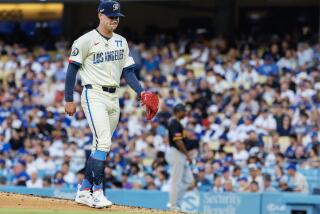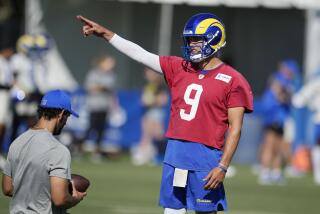Favre said to have undergone surgery
- Share via
Brett Favre recently underwent arthroscopic surgery to repair damage to his throwing shoulder, leaving open the possibility he could return to play quarterback for the Minnesota Vikings, according to an ESPN report Sunday citing two unnamed sources.
Favre’s agent, Bus Cook, did not immediately return an e-mail about the report, but declined to either confirm or deny the surgery to ESPN.com, telling the website: “That’s a confidential client privilege.”
Although the Vikings too declined to comment on the report, it’s clear that Minnesota is the only potential landing spot for Favre, should he decide to again come out of retirement.
According to the report, Favre sought the advice of orthopedic surgeon Dr. James Andrews last month and the two discussed surgical and non-surgical options. The report said Favre consented to surgery after cortisone injections and exercise failed to release the damaged tendon naturally. Also, it said the 39-year-old quarterback has thrown on a limited basis since the surgery but “has not felt close to ‘100%.’ ”
The Vikings, who already have quarterbacks Sage Rosenfels and Tarvaris Jackson as potential starters, will conduct their final organized team activity practices this week. It is likely that if they were to sign Favre, they would want to do so well in advance of their July 25 start date for training camp.
An orthopedic surgeon who has performed dozens of arthroscopic surgeries to repair torn biceps tendons said the typical recovery time is six to 12 weeks.
“It’s extremely common,” said Dr. Daniel Kharrazi of the Kerlan-Jobe Orthopaedic Clinic in Los Angeles, who spoke in generalities about the procedure, though he is not treating Favre. “There’s basically some cumulative trauma that happens with repetitive throwing, be it with pitchers in the major leagues or quarterbacks in the NFL.”
Kharrazi, who serves as orthopedic consultant for the Lakers, said similar surgeries on professional athletes are usually not simply to correct isolated problems.
“Usually it’s combined with a secondary calcium buildup or maybe some fraying of the rotator cuff,” he said. “I haven’t seen Brett Favre, but I can almost tell you that undoubtedly there’s some other things they might have had to tune up and correct with an arthroscopic surgery.”
--
More to Read
Go beyond the scoreboard
Get the latest on L.A.'s teams in the daily Sports Report newsletter.
You may occasionally receive promotional content from the Los Angeles Times.











